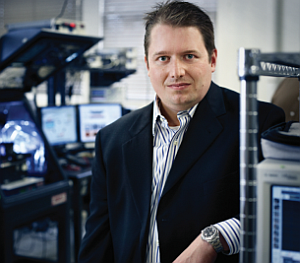Engineering researchers from University of Illinois in Urbana and Anasys Instruments Inc. in Santa Barbara, California developed analytical tools to measure and analyze nanoscale manufactured products, such as those used in electronic devices, solar cells, and medical diagnostics. The findings from the team led by Illinois engineering professor William King (pictured right) appear in the journal ACS Nano; paid subscription required.
The research by the Illinois/Anasys team aims to provide measurement tools to better analyze manufactured nanoscale structures made from multiple integrated materials. Defense Advanced Research Projects Agency, Air Force Office of Scientific Research, and Department of Energy supported the research.
The Illinois/Anasys study used atomic force microscope-based infrared spectroscopy (AFM-IR) to better understand the composition of polymer nanostructures and systems of integrated polymer nanostructures. An atomic force microscope is a type of scanning probe microscope using lasers that produces nanoscale images of surfaces; 1 nanometer equals 1 billionth of a meter.
In AFM-IR, a rapidly pulsed infrared (IR) laser aims at a thin sample of material that absorbs the infrared beam and undergoes rapid thermomechanical expansion. In response to this expansion, the AFM tip in contact with the polymer nanostructure in the sample resonates, and this resonance is in turn measured by the AFM.
The tools, say the authors, provide nanoscale manufacturers valuable tools to assess the quality of their products. Craig Prater, a co-author of the ACS Nano paper and chief technologist at Anasys Instruments says, “The AFM-IR technique offers the unique capability to simultaneously map the nanoscale morphology and perform chemical analysis at the nanoscale.”
“In this research,” King adds, “we have been able to chemically analyze polymer lines as small as 100 nanometers. We can also clearly distinguish different nanopatterned polymers using their infrared absorption spectra as obtained by the AFM-IR technique.”
Read more:
- NSF Grant to Fund Study of Energy Storage Nanomaterials
- Synthetic Nanomaterial Developed for Semiconductors
- Process Developed for Stronger Alloys at High Temperatures
- Air Force Grant to Fund Research on Nanomaterials Shaping
- Faster, Cheaper Thermoelectric Materials Process Developed
* * *


 RSS - Posts
RSS - Posts
[…] University/Company Team Develops Nanomaterial Analytic Tools […]
[…] University/Company Team Develops Nanomaterial Analytic Tools […]
[…] University/Company Team Develops Nanomaterial Analytic Tools […]
[…] University/Company Team Develops Nanomaterial Analytic Tools […]
[…] University/Company Team Develops Nanomaterial Analytic Tools […]